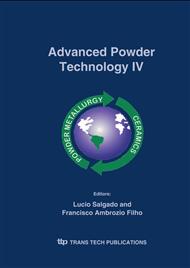p.535
p.540
p.546
p.552
p.558
p.564
p.569
p.575
p.581
Sintering of a Clay Material with Granite and Marble Reject
Abstract:
The industrial use of wastes in the brick and tile industry has been intensively investigated in the last decade. This work describes a research carried out on the manufacturing of a clay material with granite and marble reject. The reject was obtained direct by from a ceramic industry from rocks which were sawed in blocks or slices. This industrial process produces a very large amount of this reject. The reject is launched in decanting lagoon, landing area or throw in river, resulting environment pollution and degradation. The reject material was investigated in function of chemical and mineralogical compositions using x-ray diffraction and thermal analysis. Granite and marble reject and clay material were mixed and uniaxial pressed. Samples were sintered in an electric furnace at temperature range from 950 to 1150º C. The experimental results (porosity, dilatometric analyses, water absorption, x-ray diffraction) are also presented. The results indicate that it is possible to use granite and marble reject in clay material without to predicate its properties.
Info:
Periodical:
Pages:
558-563
Citation:
Online since:
November 2005
Authors:
Keywords:
Price:
Сopyright:
© 2005 Trans Tech Publications Ltd. All Rights Reserved
Share:
Citation:


